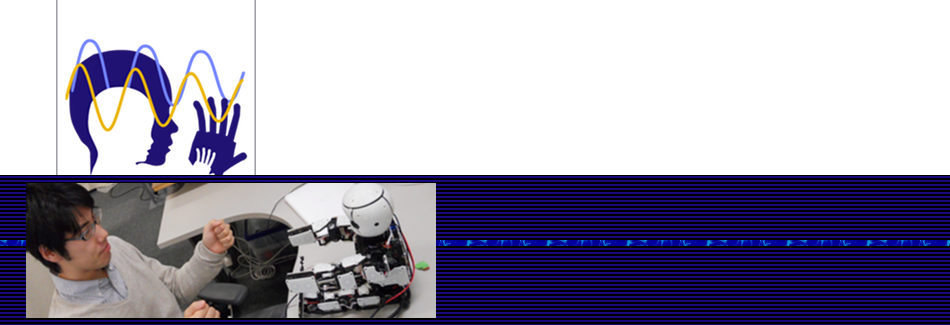Brain Imaging Group
- Overview The brain imaging group aims to verify hypotheses on the developmental process of self-other cognition with neuroscientific measures. Especially, we are trying to understand the brain structures involved in inter-personal synchronization and self-other cognition by, for example, measuring the multi-brain interaction between caregivers and children. We will innovate robots to perform brain imaging experiment in various controlled contexts. This neuroscientific research will provide the new hypotheses, based on which the developmental brain group and the psychological and behavioral experiment group can establish novel research approaches. Our groups command fMRI, EEG, and MEG measuring systems, among which especially the MEG system is highly capable of measuring the brain activities of an adult and a child at the same time in the same room. Such system are available only in two institution in the world.
- fMRI Experiment Two distinct pathways in human social brain. Recently, our fMRI team has revealed the possibility that the human social brain network consists of at least two functionally distinct sub-networks. One is the dorso-medial cingulum network to mentalize other’s mind by taking the first-person perspective that may engage dorsal TPJ. The other one is the temporal uncinate network to estimate the possible risk that their minds are envisioned by the other when the participants felt the other’s third-person perspective sensed by ventral TPJ. This success largely depends on examining social interaction not only with human but also non-human agents. Human neuroimaging research involving experiments with also non-human agents recently emerged around us (android, robot and artificial intelligence). These paradigms may help us to understand how our brains shape internal representations of social interaction with other agents and to predict how our brains evolve in future through social interaction with non-human agents.
- EEG/MEG Experiment How do parent and child communicate with each other? At the behavioral level, they communicate with speech, gesture, eye-contact and so on. However, the neural correlates of parent-child interaction remain unclear. Our group investigates parent-child interaction using the latest functional imaging techniques. Magnetoencephalogram (MEG) and electroencephalogram (EEG) are non-invasive methods to directly measure neurophysiological activities with high temporal resolution. Hence, they are suitable for investigating detailed temporal profiles of neural oscillatory activities. Using this techniques we aim to elucidate the intra- and inter-brain connectivity specific to parent-child interaction.
Masayuki Hirata, Mitsuru Kikuchi, Eiichi Naito, Tomoyo Morita, Hideyuki Takahashi, Takashi Ikeda, and Minoru Asada
Eiichi Naito, Tomoyo Morita, and Hideyuki Takahashi
Masayuki Hirata, Mitsuru Kikuchi, and Takashi Ikeda
Psychological and Behavioral Experiment Group
- Overview When and how do infants develop the ability to recognize the self? How is the development shaped by the interaction with caregivers? The group for behavioral and psychological studies aims to understand the developmental mechanisms of self-other recognition in infants. Our first study focuses on the emergence of self-agency. We examine at which age infants become intentional agents by assessing their ability to solve a scratch image task, which uses a gaze-contingent paradigm. The target of our second study, in contrast, is the mind perception by adults, that is, how adults perceive infants' mind and how it influences their own care-taking behaviors. Our ongoing brain imaging studies reveal an adaptive use of the multiple dimensions of adults' mind perception, which is suggested to facilitate the infant development of self-other recognition. The third study investigates the dynamics of infant-caregiver interaction. Our research questions are when and how infants start distinguishing the self from others and how this process is assisted by caregivers. We seek to find quantitative answers to these questions by means of information theoretic measures.
Yukie Nagai, Michiko Miyazaki, and Hideyuki Takahashi
Developmental Brain Simulation Group
- Overview The simulation group for brain development constructs a brain model that synchronizes and de-synchronizes with the surrounding environment and other agents. We thereby take into account the entire range from the micro level of neural networks to the macro level of behaviors. The simulation group cooperates with the project's brain imaging group and behavioral measuring group. This cooperation aims to construct a brain model that explains their experimental data from a constructivist point of view with both bottom-up and top-down approaches. In the bottom-up approach, we develop large-scale computational simulations of brain development as to investigate how macro scale human behavior is generated from micro scale neural activities. In the top-down approach, we develop a macro scale framework for a communication robot to which we can compare synchronization/desynchronization in communication between human and robot.
- Motor Learning through Goal Babbling How do infants incrementally learn to coordinate their ever-changing bodies with hundreds of degrees of freedom? How do they tell percepts of themselves from percepts of the environment and others within high-dimensional sensory streams? How do goals structure sensorimotor development, and how to goals themselves develop?We investigate these questions by developing motor learning methods based on the concept of “goal babbling”, which mimics early goal-directed movement attempts that are already observed in newborns' motion. We seek for solutions at conceptual, algorithmic, and theoretic levels that solve the above mentioned questions together and in a coherent manner. We thereby want to contribute hypotheses on the mechanisms of infant development as well as practically useful algorithms.
Masaki Ogino, Hiroki Mori, Matthias Rolf, and Minoru Asada
Matthias Rolf
Robot Development Group
- Overview Since robots could be interfaces between brain computer simulations and real surrounding environments including humans. Consequently, they can be useful tools for testing hypothesized developmental mechanism if they are designed appropriately. Our group is trying to create several robots that would be appropriate for each research target: “Pneuborn” is a child robot that has complex musculoskeletal body actuated by a set of mechanically-flexible pneumatic actuators. “Affetto” is an android-type child robot that is designed to give humans a realistic impression of a real child. “Child-type vocal tract robot” is designed to articulate child-like voice in a similar way as children. “Flexible master-slave robot system” is actuated by pneumatic actuators. We have been tackling the development of these robots simultaneously with the concept of “flexibility for interaction”. We will try to research how the robots can learn to control their flexible body and how they can interact with humans by utilizing the brain simulation models developed in the neuroscientific and psychological experiments.
Koh Hosoda, Kenichi Narioka, Hisashi Ishihara, Nobutsuna Endo, and Minoru Asada






